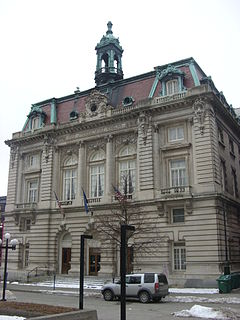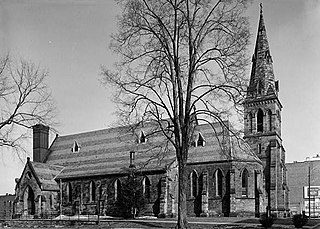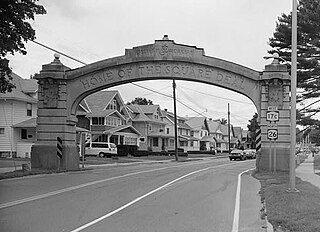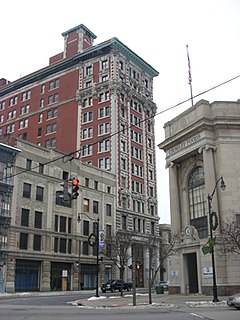
Binghamton is a city in, and the county seat of, Broome County, New York, United States. It lies in the state's Southern Tier region near the Pennsylvania border, in a bowl-shaped valley at the confluence of the Susquehanna and Chenango Rivers. Binghamton is the principal city and cultural center of the Binghamton metropolitan area, home to a quarter million people. The population of the city itself, according to the 2010 census, is 47,376.

The Cyrus Gates Farmstead is located in Maine, New York. Cyrus Gates was a cartographer and map maker for New York State, as well as an abolitionist. The great granddaughter of Cyrus-Louise Gates-Gunsalus has stated that from 1848 until the end of slavery in the United States in 1865, the Cyrus Gates Farmstead was a station or stop on the Underground Railroad. Its owners, Cyrus and Arabella Gates, were outspoken abolitionists as well as active and vital members of their community. Historian Shirley L. Woodward states that through those years escaped slaves came through the Gates' station.

The Phelps Mansion, formerly known as The Monday Afternoon Clubhouse, is a three-story brick and stone mansion located on Court Street in Binghamton, New York. It was built in 1870 as the private home of Sherman D. Phelps. Mr. Phelps was a successful business man, banker, Republican elector for Abraham Lincoln, and mayor of the City of Binghamton. The building was designed by Isaac G. Perry who later became the chief architect for the New York State Capitol building in Albany, New York.

The Roberson Mansion, part of the Roberson Museum and Science Center, is a home in Binghamton, New York. It is an Italian Renaissance style house, designed by Binghamton architect C. Edward Vosbury and built in 1904, and completed in 1907, for Alonzo Roberson Jr. and his wife Margaret Hays Roberson. It was built with all of the then modern conveniences: an elevator, central heat, combination gas and electric lighting, a dumb waiter, an intercom system, and a private bath for each bedroom.

Broome County Courthouse is a historic courthouse located at Binghamton in Broome County, New York. It is a massive 2 1⁄2-story structure, built on a raised foundation, in the form of a Latin Cross and topped with an elegant copper dome. Originally constructed in 1897–1898 in a "T" shape, the south wing was added in 1916-1917 to form the cross. It was designed by noted New York State architect Isaac G. Perry. The courthouse is located within the boundaries of the Court Street Historic District.

Binghamton City Hall is a historic city hall located at Binghamton in Broome County, New York.

The Broome County Forum Theatre, also known as the Forum, Capri Theatre, and the Broome Center for the Performing Arts, is a historic theater, located at Binghamton, in Broome County, New York. The theater seats 1,522 with a pit orchestra and 1,553 without it.

Christ Church is a historic Episcopal church located at Binghamton in Broome County, New York. It is a one-story bluestone structure with Gothic Revival elements. The church consists of a rectangular central section housing the nave and aisles, an apse and bell tower on the east facade, and side entrances through transepts on the north and south elevations. It was built between 1853 and 1855 and was designed by noted church architect Richard Upjohn, (1802-1878).

The Building at 171–177 Clinton Street, also known as Bruun and Co. and Afga Ansco, No. 99, is a historic commercial building located at Binghamton in Broome County, New York. It is a two-story, two part brick commercial block built in 1920. The first floor is divided into four storefronts and the second floor contains the remnants of offices and apartments. The building was purchased in the 1940s by General Aniline & Film and housed a number of GAF offices and facilities.

Endicott Square Deal Arch is an historic "welcome arch" located at Endicott in Broome County, New York. It is one of two identical arches erected in 1920 in Endicott and in nearby Johnson City, known as the Johnson City Square Deal Arch.. It was constructed by Endicott-Johnson Shoe Company employees to honor George F. Johnson (1857–1948), their highly respected employer and benefactor.

Jonas M. Kilmer House, also known as Temple Concord, is a historic home located at Binghamton in Broome County, New York. It was constructed in 1898 and is a large 3 1⁄2-story residence using an eclectic Victorian-era vocabulary. It is primarily constructed of stone and features irregular form and massing. The building is characterized by a variety of different sized gables and turrets, all surmounted by a high hipped roof clad in asbestos shingles. Jonas M. Kilmer (1843–1912) was the father of Willis Sharpe Kilmer (1869–1940).

Washingtonian Hall, also known as Amos Patterson House, is a historic home located at Endwell in Broome County, New York. It is a two-story, five bay, center entrance, frame Federal style house built in 1799–1800. It was moved a short distance from its original site in 1924 and subsequently remodeled in the Colonial Revival style. Also on the property are contributing structures dating to the mid-1920s including a carriage barn, small frame horse barn, pergola, brick driveway, garden house, and picket fence.

C. Fred Johnson Park Carousel is a historic carousel located at Johnson City in Broome County, New York. The carousel and its pavilion were built in 1923. The carousel is housed in a wooden, two story, 18-sided, enclosed pavilion topped by a six sided cupola. The carousel has 72 figures - all horses - each of which is a "jumper." It was constructed by the Allan Herschell Company. It is one of six carousels donated to the citizens of Broome County by George F. Johnson (1857–1948), president of Endicott Johnson Corporation.

George F. Johnson Recreation Park Carousel is a historic carousel located at Binghamton in Broome County, New York. The carousel and its pavilion were built in 1925. The carousel is housed in a wooden, one story, 16-sided, pavilion topped by a cupola. The carousel has 60 horses standing four abreast, each of which is a "jumper," and two chariots. It was constructed by the Allan Herschell Company and contains its original Wurlitzer Military Band Organ. It is one of six carousels donated to the citizens of Broome County by George F. Johnson (1857–1948), president of Endicott Johnson Corporation.

George W. Johnson Park Carousel is a historic carousel located at Endicott in Broome County, New York. The carousel and its pavilion were built in 1934. The carousel is housed in a wooden, one story, 16-sided, pavilion. The carousel has 36 horses standing three abreast, each of which is a "jumper," and two chariots. It was constructed by the Allan Herschell Company. It is one of six carousels donated to the citizens of Broome County by George F. Johnson (1857–1948), president of Endicott Johnson Corporation.

Marlborough Building, also known as Marlborough Hotel, State Bank of Binghamton, State Hotel, and Marble Grill, is a historic building located at Binghamton in Broome County, New York. It was built in 1914 and is a three-story, five bay commercial building with a one-story addition and upper level stacked porches projecting from the rear. The front facade features a stepped parapet with a cast cartouche ornamented with foliage flanked by decorative cast stone foliage. It was built as a hotel and housed a bank on its first floor until 1930. From the 1940s to 1990s, the first floor was used for commercial establishments with apartments above.

Ouaquaga Lenticular Truss Bridge is a historic lenticular truss bridge located at Ouaquaga in the towns of Windsor and Colesville in Broome County, New York. It was constructed in 1888 and spans the Susquehanna River. It is composed of two identical through trusses with an overall length of 343 feet (105 m). It was constructed by the Berlin Iron Bridge Co. of East Berlin, Connecticut. The bridge was closed to vehicular traffic in 2008 when a new bridge was built alongside it. The old bridge remains open for pedestrian use.

Court Street Historic District is a national historic district located at Binghamton in Broome County, New York. The district includes 87 contributing buildings and encompasses the historic downtown core of downtown Binghamton. The majority of the contributing structures are commercial buildings built between about 1840 and 1939. Ten and twelve story office buildings built in the 20th century are prominent features of the district. Located within the boundaries of the district are the separately listed Broome County Courthouse and Binghamton City Hall.

Railroad Terminal Historic District is a national historic district in Binghamton in Broome County, New York. The district includes 19 contributing buildings. Four of the buildings were directly related to Binghamton's rail passenger and freight operations, including the passenger station. Five buildings were built as warehouses, and ten were built to house retail activities with residential or office uses on the upper floors. The buildings were built between 1876 and 1910, with a major addition to one of them completed in 1932. This Delaware, Lackawanna and Western Railroad passenger station, with its Italian Renaissance campanile, was built in 1901. For most years of passenger service to Binghamton Delaware and Hudson Railway and Erie Railroad trains used the station 150 yards away.

J. Stuart Wells House, now the Ernest H. Parsons Funeral Home, is a historic home located at Binghamton in Broome County, New York, USA. It was built in 1867-1870 and designed by the noted New York State architect Isaac G. Perry. It is a 2 1⁄2-story brick dwelling on a cut stone foundation and topped by a hipped, cross-gabled roof. It was expanded in the 1940s-1950s and features a wrap-around porch. Also on the property is a 2-story brick carriage house.

























